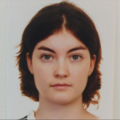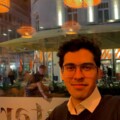Where can we go: telling and feeling the cityscape’s multiplicity
The emerging curator Kali Itouad in collaboration with follow.art, presents an exhibition available online from 17.06 to 16.08.2024.
Few exhibitions can claim to be as multifaceted and subjective as “Where can we go”. Indeed, it is plural and inclusive in many ways, featuring artists from various backgrounds using a diverse range of mediums - drawings, digital art, photography, sculpture and paintings.
The exhibition develops the urban theme and the ambivalent cityscape. Kali Itouad aims to explore the intersections of urbanization and colors through various artistic expressions. The city reveals itself in all forms and for all purposes: whether as it be ruins, odd buildings, “negative spaces”, or central districts as metaphors for the heart of a living organism.
"Where Can We Go" provides an online platform for artists to showcase their talent and contribute to a collective dialogue on the topic. For most of the artists participating, the online format is a new and exciting way of showing artworks. For example, for Simon PAPPO it is an opportunity to escape social media as the sole way to share art. The artist Delila Mameri shares the same excitement to test the limits of 3D artworks in a 2D environment. In her craft, she goes so far as to “test the limits of paper as a material,” resulting in “the drawings of a sculptor.”

It is the first collaboration between French curator and follow.art, however, the “French” characteristic isn’t what stands out the most when looking at Kali Itouad’s multicultural journey. A Master II student at ICART Paris, he began his journey in contemporary art as an assistant gallerist at Galerie-Art-Z, known for emerging African contemporary art. He freelanced for SYMANews, writing about African artists. His travels, including to the 2020 World Expo in Dubai and the 2024 1-54 fair in Marrakech, helped him discover new talent and refine his critical eye. An internship at Gagosian Gallery deepened his industry knowledge, and he advised artists like Dolet and French photographer Charles Fréger. At Sébastien Moreu publishing house, he gained insights into current artistic trends and honed his communication and marketing skills. This diverse experience shapes his current role as a curator, where he explores rapidly evolving urbanism and self-alienation in modern landscapes, transforming the spectator’s role into one of scientific curiosity. "The city reveals itself as a living organism, one 'of its own right,'" says Itouad.

The exhibition explores the connections between figurative art and architecture –– the “useful” art per excellence. Maybe this is the reason why ethics hold such a role in it. According to Nicolas Guyot (Nicoye), it involves understanding “the influence of urbanism and architecture on our bodies in the urban space”.
Olga Trebuhina stresses the symbiosis: “We form the space, the space forms us in return.” Living in a city today reflects both old and new concerns of late-stage capitalism. It costs us more than just our time and effort, but also our flesh and integrity. This mindset influences Delila Mameri’s creations: “otherness, slowness, poetry and gentleness restore our humanity.” The alienation felt in the city isn’t due to the city itself, but rather our use of it: “the city isn’t per se functional or rational.” The consensus remains that slow pace belongs to the countryside, along with any form of freedom. Hence, Mameri claims, “linking aesthetics to ethics would enable us to live together better.”
Jeryce Dianingana uses the city’s very material as the base for his artworks, aligning with Simon PAPPO’s belief that art mimics the real world, yet still structures it.
Dianingana treats “buildings and streets the same way a sculptor would treat a block of marble before giving it a shape.”
New visions on ethics in the artworks jumpstart contemplation and reflection when the question is asked: how can we live together?
Art builds the connection between the viewer and the city, acknowledges this link and finds a common ground in searching for answers.

Showing the city is a strategy to reveal what the city truly lacks. This is why the call for more nature and unused voids in the cluttered cityscape is almost always the message of these artworks, especialy those that revendicate a moral positioning. The overwhelming urban paradigm can make us forget that nature once existed in the negative spaces, which still outrun capitalist interests of profitability. This loss of anchors in the modern city brings forth a reflection on contemporary ways of practicing religion. Jeryce Dianingana asserts that the most interesting building in a city is a religious one, as it “brings the people together in many ways (…) without a third party coming in-between.”
“Where can we go” offers a smart and peculiar refocusing on what it means to observe a distant subject from above. Is art so timeless that we can afford to extract ourselves from the masses we want to impact? There is escapism in exploring fictional possibilities, making the storyteller an almighty narrator. Finding oddities in a place stimulates imagination. The exhibition also revolutionizes this medium, allowing one to read sculptures, decipher abstract pieces, and feel drawings, each as its own story. Listening to Delila Mameri provides this key understanding: the city has narrative possibilities beyond the material plane; the maps are conceptual structures that might as well be scripts.

Common conclusions tend to emerge among the participating artists about what to call cities today. There is intimidating complexity within the city’s logic, and art deconstructs it to make sense of it. However, there is optimism in representing the city in one’s unique way: cities contain liberation potential if you look for it. Indeed, Filippa af Buren perceives the city as the modern way we have found to gather in tribes, alongside our kind. On another note, Catherine Olivier even claims her subject matter isn’t the city itself anymore, but rather the places and feelings within it. This hide-and-seek dynamic gives inspiration and sometimes life lessons for the artists. Ultimately, Olga Trebuhina stresses that understanding and agreeing with each other as individuals in the city resembles the selfless connection between the artist and the spectator learning from the artwork.
Artists participating in the exhibition:
Share the post:













